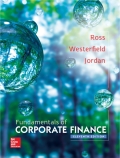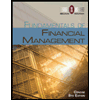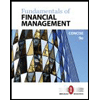
a)
To compute: The value of Publication IR to Company B.
Introduction:
Merger is the complete absorption of one company by another company. The acquiring company acquires all the assets and liabilities of the acquired firm and acquiring firm retains its name and identity. The acquired firm ceases to exist as a separate business entity after a merger.
a)
Answer to Problem 14QP
The value of Publications I to Company B is $9,857,250.
Explanation of Solution
Given information:
“Company B” is analysing the purchase of “Publications I”. Company B expects that earnings and dividends of Publications I to grow at a constant rate of 5% every year. Because of synergy, Company B’s growth rate will increase to 7% each year.
The price earnings ratio of Company B and Publications I are 14.5% and 9.2% respectively. The outstanding shares of Company B and Publications I are $1,400,000 and $195,000 respectively. The earnings of Company B and Publications I are $4,300,000 and $705,000 respectively and the dividends of Company B and Publications I are $1,075,000 and $375,000 respectively.
Formula to calculate the value of Publications I to Company B:
Calculate the value of Publications I to Company B:
Hence, the value of Publications I to Company B is $3.61538 per share.
Formula to calculate the share price of Target Company (I Publications):
Calculate the share price of Target Company (I Publications):
Hence, the share price of the target company is $33.261496.
Formula to calculate the dividend per share:
Calculate the dividend per share:
Hence, the dividend of Publications I is $1.923.
Formula to calculate the required
Calculate the required rate of return for the target company’ shareholders:
Hence, the required return of Publications I is 11.07%.
Formula to calculate the share price of the target company with new growth rate:
Calculate the share price of the target company with new growth rate:
Hence, the share price of the target company is $50.55.
Formula to calculate the value of Publications I to Company B:
Calculate the value of Publications I to Company B:
Hence, the value of Publications I to Company B is $9,857,250.
b)
To compute: The gain of Company B from the acquisition.
Introduction:
Merger is the complete absorption of one company by another company. The acquiring company acquires all the assets and liabilities of the acquired firm and acquiring firm retains its name and identity. The acquired firm ceases to exist as a separate business entity after a merger.
b)
Answer to Problem 14QP
Company B’s gain from acquisition is $3,371,258.28.
Explanation of Solution
Given information:
“Company B” is analysing the purchase of “Publications I”. Company B expects that earnings and dividends of Publications I to grow at a constant rate of 5% every year. Because of synergy, Company B’s growth rate will increase to 7% each year.
The price earnings ratio of Company B and Publications I are 14.5% and 9.2% respectively. The outstanding shares of Company B and Publications I are $1,400,000 and $195,000 respectively. The earnings of Company B and Publications I are $4,300,000 and $705,000 respectively and the dividends of Company B and Publications I are $1,075,000 and $375,000 respectively.
Formula to calculate Company B’s gain from the acquisition:
Calculate Company B’s gain from the acquisition:
Hence, Company B’s gain from acquisition is $3,371,258.28.
c)
To compute: The
Introduction:
Merger is the complete absorption of one company by another company. The acquiring company acquires all the assets and liabilities of the acquired firm and acquiring firm retains its name and identity. The acquired firm ceases to exist as a separate business entity after a merger.
c)
Answer to Problem 14QP
The NPV of the acquisition is $2,447,250.
Explanation of Solution
Given information:
“Company B” is analysing the purchase of “Publications I”. Company B expects that earnings and dividends of Publications I to grow at a constant rate of 5% every year. Because of synergy, Company B’s growth rate will increase to 7% each year.
The price earnings ratio of Company B and Publications I are 14.5% and 9.2% respectively. The outstanding shares of Company B and Publications I are $1,400,000 and $195,000 respectively. The earnings of Company B and Publications I are $4,300,000 and $705,000 respectively and the dividends of Company B and Publications I are $1,075,000 and $375,000 respectively.
Formula to calculate the NPV of the acquisition, if Company B offers $38 in cash for each share of Publications I:
Calculate the NPV of the acquisition, if Company B offers $38 in cash for each share of Publications I.
Hence, the NPV of the acquisition at $38 offer price is $2,447,250.
d)
To compute: The maximum bidding price that Company B will be willing to pay for Publications I.
Introduction:
Merger is the complete absorption of one company by another company. The acquiring company acquires all the assets and liabilities of the acquired firm and acquiring firm retains its name and identity. The acquired firm ceases to exist as a separate business entity after a merger.
d)
Answer to Problem 14QP
The maximum bid price is $50.55.
Explanation of Solution
Given information:
“Company B” is analysing the purchase of “Publications I”. Company B expects that earnings and dividends of Publications I to grow at a constant rate of 5% every year. Because of synergy, Company B’s growth rate will increase to 7% each year.
The price earnings ratio of Company B and Publications I are 14.5% and 9.2% respectively. The outstanding shares of Company B and Publications I are $1,400,000 and $195,000 respectively. The earnings of Company B and Publications I are $4,300,000 and $705,000 respectively and the dividends of Company B and Publications I are $1,075,000 and $375,000 respectively.
Formula to calculate the maximum bid price:
Hence, Company B’s maximum bid price is $50.55.
e)
To compute: The NPV of the acquisition, if Company B was offered $205,000 of its shares for the stock outstanding of Publications I.
Introduction:
Merger is the complete absorption of one company by another company. The acquiring company acquires all the assets and liabilities of the acquired firm and acquiring firm retains its name and identity. The acquired firm ceases to exist as a separate business entity after a merger.
e)
Answer to Problem 14QP
The NPV is $634,300.
Explanation of Solution
Given information:
“Company B” is analysing the purchase of “Publications I”. Company B expects that earnings and dividends of Publications I to grow at a constant rate of 5% every year. Because of synergy, Company B’s growth rate will increase to 7% each year.
The price earnings ratio of Company B and Publications I are 14.5% and 9.2% respectively. The outstanding shares of Company B and Publications I are $1,400,000 and $195,000 respectively. The earnings of Company B and Publications I are $4,300,000 and $705,000 respectively and the dividends of Company B and Publications I are $1,075,000 and $375,000 respectively.
Formula to compute the EPS of Company B:
Calculate the EPS of Company B:.
Hence, the EPS of Company B is $3.07143.
Formula to calculate the share price of Company B:
Calculate the share price of Company B:
Hence, the share price of Company B is $44.5357.
Formula to calculate the market value of Company B:
Calculate the market value of Company B:
Hence, the market value of Company B is $62,349,980.
Formula to calculate the price of the stock in the merged firm:
Calculate the price of the stock in the merged firm:
Hence, the price of the merged firm stock is $44.99.
Formula to calculate the NPV:
Calculate the NPV:
Hence, NPV is $634,300, if Company B offers 205,000 shares in exchange for outstanding stock of Publications I.
f)
To discuss: Whether the acquisition must be attempted and the acquisition that must be tried.
Introduction:
Merger is the complete absorption of one company by another company. The acquiring company acquires all the assets and liabilities of the acquired firm and acquiring firm retains its name and identity. The acquired firm ceases to exist as a separate business entity after a merger.
f)
Explanation of Solution
Given information:
“Company B” is analysing the purchase of “Publications I”. Company B expects that earnings and dividends of Publications I to grow at a constant rate of 5% every year. Because of synergy, Company B’s growth rate will increase to 7% each year.
The price earnings ratio of Company B and Publications I are 14.5% and 9.2% respectively. The outstanding shares of Company B and Publications I are $1,400,000 and $195,000 respectively. The earnings of Company B and Publications I are $4,300,000 and $705,000 respectively and the dividends of Company B and Publications I are $1,075,000 and $375,000 respectively.
Yes, the acquisition should go further, and Company B should offer cash of $38 for each share of Publications I.
g)
To compute: The NPV, if the outside financial consultants of Company B feel that the growth rate is very optimistic at 7% and it is realistic at 6%.
Introduction:
Merger is the complete absorption of one company by another company. The acquiring company acquires all the assets and liabilities of the acquired firm and acquiring firm retains its name and identity. The acquired firm ceases to exist as a separate business entity after a merger.
g)
Answer to Problem 14QP
The reduction in growth rate, results in positive NPV for cash offer and negative NPV for stock offer.
Explanation of Solution
Given information:
“Company B” is analysing the purchase of “Publications I”. Company B expects that earnings and dividends of Publications I to grow at a constant rate of 5% every year. Because of synergy, Company B’s growth rate will increase to 7% each year.
The price earnings ratio of Company B and Publications I are 14.5% and 9.2% respectively. The outstanding shares of Company B and Publications I are $1,400,000 and $195,000 respectively. The earnings of Company B and Publications I are $4,300,000 and $705,000 respectively and the dividends of Company B and Publications I are $1,075,000 and $375,000 respectively.
Formula to calculate the share price of the target company with changed growth rate:
Calculate the share price of the target company with changed growth rate.
Hence, the share price of the target company with changed rate of growth is $40.20.
Formula to calculate the value of Publications I to Company B:
Calculate the value of Publications I to Company B:
Hence, the value of Publications I to Company B is $7,839,000.
Formula to calculate Company B’s gain from acquisition:
Calculate Company B’s gain from acquisition:
Hence, the gain is $6,485,991.72.
Formula to calculate the NPV of the acquisition, if Company B offers $38 in cash for each share of Publications I.
Calculate the NPV of the acquisition, if Company B offers $38 in cash for each share of Publications I.
Hence, the NPV for cash is 429,000.
Formula to calculate the price of the stock in the merged firm:
Calculate the price of the stock in the merged firm:
Hence, the price of the merged stock firm is $43.73.
Formula to calculate the NPV for stock offer:
Calculate the NPV for stock offer:
Note:
- EPS represents Earnings Per Share
- NPV represents Net
Present Value - P represents Share price
- DPS represents Dividend Per Share
- V represents Market Value
Hence, the NPV for stock is -$1,125,650.
Want to see more full solutions like this?
Chapter 26 Solutions
Fundamentals of Corporate Finance
- hello tutor:If submitted image is blurr then please comment i will write values. i will give unhelpful please.arrow_forwardLara Fredericks is interested in two mutually exclusive investments. Both investments cover the same time horizon of 5 years. The cost of the first investment is $9900, and Lara expects equal and consecutive year-end payments of $3400. The second investment promises equal and consecutive payments of $4100 with an initial outlay of $12500 required. The current required return on the first investment is 8.4 %, and the second carries a required return of 10.4 %.a. What is the net present value of the first investment?b. What is the net present value of the second investment?c. Being mutually exclusive, which investment should Lara choose? d. Which investment is relatively more risky? Explain.arrow_forwardWhat are some of the characteristics of a firm with a long operating cycle?arrow_forward
- About this Assignment For this Corporate Finance 301 assignment, you will submit a research paper that analyzes the types of organizational business structures. You will apply knowledge of business structure concepts as acquired in the course. The research paper should follow APA formatting style. Project Prompts The written research paper should be at least 1,000 to 1,200 words in length and should include four sections based on the business structures studied throughout the course. Define each business structure, compare the corporate finance strategies of the four business structures, discuss the advantages and disadvantages of each business structure, and how each varies in taxation. Research Paper Sections ⚫ Sole Proprietorship ⚫ Partnership • Corporation ⚫ Limited Liability Company (LLC)arrow_forwardPLEASE ANSWER THE COLUMN FULLY AND CORRECTLY PLEASE DO THE RIGHT CALCULATION DOUBLE CHECK AS WELL TO GIVE ME THE RIGHT ANSWER REQUIRED: Given the following information, what are the NZD/SGD currency against currency bid-ask quotations? Note: Do not round intermediate calculations. Round your answers to 4 decimal places. Bank Quotations American Terms European Terms Bid Ask Bid Ask New Zealand dollar 0.733 0.7340 1.3870 1.3884 Singapore dollar 0.6186 0.6191 1.6423 1.6436 answer Bid Ask New Zealand dollar ? ? Singapore dollar ? ?arrow_forwardAbout this Assignment For the Corporate Finance 301 assignment, you will submit a research paper that analyzes and discusses organizational financial risks. You will apply knowledge acquired in the course and use the concepts of multiple financial risks as the basis of research and analysis. The research paper should follow APA formatting style. Audience: upper-level business students. Project Prompt Write a 1,000-1,200-word analysis discussing financial risk concepts and assess the impact of the different financial risks on an organization. For this assignment, you will structure your assignment using four research paper sections associated with corporate risk management, as studied in the course. Base your research paper on the financial statements analyzed in Corporate Finance 301 assignment 2 and apply the knowledge acquired in the analysis. Define each financial risk, discuss the risk associated components, and evaluate the financial risks and how they affect the corporation's…arrow_forward
- Bobby Nelson, made deposits of $880 at the end of each year for 6 years. Interest is 6% compounded annually. What is the value of Bobby’s annuity at the end of 6 years?arrow_forward1. Find the future value if $1,250 is invested in Simple interest account paying 6.5%: a. for 5 years b. for 20 years 2. Find the future amount $ 35,000 is invested for 30 years at 4.25% compounded: a. annually b. Quarterly c. monthly d. weekly 3. How much should be put into an account today that pays 7.75% compounded monthly if you need $10,000 in 5 years. 4. Find the effective rate for: a. 5.75% compounded quarterly b. 6.25% compounded daily. 5. $50 is invested at the end of each month into an account paying 7.5% compounded monthly. How much will be in the account after 5 years?…arrow_forwardSolve step by step no aiarrow_forward

 Financial Reporting, Financial Statement Analysis...FinanceISBN:9781285190907Author:James M. Wahlen, Stephen P. Baginski, Mark BradshawPublisher:Cengage Learning
Financial Reporting, Financial Statement Analysis...FinanceISBN:9781285190907Author:James M. Wahlen, Stephen P. Baginski, Mark BradshawPublisher:Cengage Learning Intermediate Financial Management (MindTap Course...FinanceISBN:9781337395083Author:Eugene F. Brigham, Phillip R. DavesPublisher:Cengage Learning
Intermediate Financial Management (MindTap Course...FinanceISBN:9781337395083Author:Eugene F. Brigham, Phillip R. DavesPublisher:Cengage Learning Fundamentals Of Financial Management, Concise Edi...FinanceISBN:9781337902571Author:Eugene F. Brigham, Joel F. HoustonPublisher:Cengage Learning
Fundamentals Of Financial Management, Concise Edi...FinanceISBN:9781337902571Author:Eugene F. Brigham, Joel F. HoustonPublisher:Cengage Learning Fundamentals of Financial Management, Concise Edi...FinanceISBN:9781285065137Author:Eugene F. Brigham, Joel F. HoustonPublisher:Cengage Learning
Fundamentals of Financial Management, Concise Edi...FinanceISBN:9781285065137Author:Eugene F. Brigham, Joel F. HoustonPublisher:Cengage Learning Fundamentals of Financial Management, Concise Edi...FinanceISBN:9781305635937Author:Eugene F. Brigham, Joel F. HoustonPublisher:Cengage Learning
Fundamentals of Financial Management, Concise Edi...FinanceISBN:9781305635937Author:Eugene F. Brigham, Joel F. HoustonPublisher:Cengage Learning





